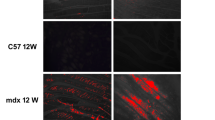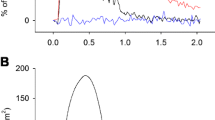Abstract
Mitochondrial inclusion bodies are often described in skeletal muscle of patients suffering diseases termed mitochondrial myopathies. A major component of these structures was discovered as being creatine kinase. Similar creatine kinase enriched inclusion bodies in the mitochondria of creatine depleted adult rat cardiomyocytes have been demonstrated. Structurally similar inclusion bodies are observed in mitochondria of ischemic and creatine depleted rat skeletal muscle. This paper describes the various methods for inducing mitochondrial inclusion bodies in rodent skeletal muscle, and compares their effects on muscle metabolism to the metabolic defects of mitochondrial myopathy muscle. We fed rats with a creatine analogue guanidino propionic acid and checked their soled for mitochondrial inclusion bodies, with the electron microscope. The activity of creatine kinase was analysed by measuring creatine stimulated oxidative phosphorylation in soleus skinned fibres using an oxygen electrode . The guanidino propionic acid-rat soleus mitochondria displayed no creatine stimulation, whereas control soleus did, even though the GPA soled had a five fold increase in creatine kinase protein per mitochondrial protein. The significance of these results in light of their relevance to human mitochondrial myopathies and the importance of altered muscle metabolism in the formation of these crystalline structures are discussed. (Mol Cell Biochem 174: 283–289, 1997)
Similar content being viewed by others
References
Luft R, Ikkos D, Palmieri G, Ernster L, Afzelius B: A case of severe hypermetabolism of non-thyroid origin with a defect in the maintenance of mitochondrial respiratory control: a correlated clinical, biochemical and morphological study. J Clin Invest 41: 1776–1804, 1962
Wallace DC: Diseases of mitochondrial genes. Ann Rev Biochem 61: 1175–1212, 1992
Schröder JM, Krämer KG, Hopf HC: Granular nuclear inclusion body disease: fine structure of tibial muscle and sural nerve. Muscle and Nerve 8: 52–59, 1985
Stadhouders AM, Jap P, Winkler HP, Eppenberger HM, Wallimann T: Mitochondrial creatine kinase: A major constituent of pathological inclusions seen in mitochondrial myopathies. Proc Natl Acad Sci 91: 5089–5093, 1994
Farrants GW, Hovmöller S, Stadhouders ADM: Two types of mitochondrial crystals in diseased human skeletal muscle fibres. Muscle and Nerve 11: 45–55, 1988
Ohira Y, Kanzaki M, Chen CS: Intramitochondrial inclusions caused by depletion of creatine in rat skeletal muscles. Jap J Physiol 38: 159–166, 1988
Shoubridge EA, Challiss RAJ, Hayes DJ, Radda GK: Biochemical adaptation in the skeletal muscle of rats depleted of creatine with the substrate analogue beta-guanidinopropionic acid. Biochem J 232: 125–131, 1985
Wyss M, Wallimann T: Creatine metabolism and the consequences of creatine depletion in muscle. Mol Cell Biochem 133/134: 51–66, 1994
Wallimann T, Wyss M, Brdiczka D, Nicolay K: Intracellular compartmentation, structure and function of creatine kinase isoenzymes in tissues with high and fluctuating energy demands: the 'phosphocreatine circuit' for cellular energy homeostasis. Biochem J 281: 21–40, 1992
Clarke JF, Khuchua Z, Kuznetzov AV, Vasssilteva E, Boehm E, Radda GK, Saks V: Actions of the creatine analogue ?-guanidinopropionic acid on rat heart mitochondria. Biochem J 300: 211–216, 1994
Ren JM, Ohira Y, Holloszy JO, Hämäläinen N, Traub I, Pette D: Effects of b-guanidinopropionic acid-feeding on the patterns of myosin isoforms in rat fast-twitch muscle. Euro J Physiol 430: 389–393, 1995
O'Gorman E, Beutner G, Wallimann T, Brdiczka D: Differential effects of creatine depletion on the regulation of enzyme activities and on creatine-stimulated mitochondrial respiration in skeletal muscle, heart and brain, Biochim Biophys Acta 1276: 161–170, 1996
Eppenberger-Erberhardt M, Riesinger I, Messerli M, Schwarb P, Müller M, Eppenberger HM, Wallimann T: Adult rat cardiomyocytes cultured in creatine-deficient medium display large mitochondria with paracrystalline inclusions, enriched for creatine kinase. J Cell Biol 113: 289–300, 1991
Riesinger I, Haas C, Wallimann T: Mitochondrial inclusions induced by feeding with a creatine analogue exhibit a high density of mitochondrial creatine kinase. EBEC Short Reports (Biochim Biophys Acta) 7: 140, 1992
O'Gorman E, Fuchs K, Brdiczka D, Wallimann T: Structural and functional analyses of intra-mitochondrial inclusions found in rat soleus muscle cells induced by creatine depletion. J Mol Med (Abstracts) 73: B49 No. 70, 1995
Rowley GL, Greenleaf AL, Kenyon GL: On the specificity of creatine kinase. New glycocyamines and glycocyamine analogs related to creatine. J Am Chem Soc 93: 5542–5551, 1971
Müller M, Moor H: Cryofixation of suspensions and tissues by propanejet freezing and high-pressure freezing. Proc. 42nd Ann Meet Electron Microsc Soc Am 6–9, 1984
Kunz WS, Kuznetov AV, Schulze W, Eichhorn K, Schild L, Striggow F, Bohnensack R, Neuhof S, Grasshof H, Neumann HF, Gellerich FN: Functional characterization of mitochondrial oxidative phosphorylation in saponin-skinned human muscle fibres. Biochim Biophys Acta 1144: 46–53, 1993
Saks VA, Rosenshtraukh LV, Smirnov N, and Chazov EI: Role of creatine phosphokinase in cellular function and metabolism. Can J Physiol Pharmacol 56: 691–706, 1987
Clarke JF, Khuchua Z, Kuznetzov AV, Vasssil'eva E, Boehm E, Radda GK, Saks V. Actions of the creatine analogue b-guanidinopropionic acid on rat heart mitochondria. Biochem J 300: 211–216, 1994
Karpati G, Carpenter S, Melmed C, Eisen AA: Experimental ischemic myopathy. J Neurol Sci 23:129 –161, 1974
Hanzlikova V, Schiaffino S: Mitochondrial changes in ischemic skeletal muscle. J Ultrast Res 60: 121–133, 1977
Reznik M and Hansen JL: Mitochondria in degenerating and regenerating skeletal muscle. Arch Pathol 87: 601–608, 1969
Meyer AR, Brown TR, Krilowicz BL, Kushmerick MJ: Phosphagen and intracellular pH changes during contraction of creatine-depleted rat muscle. Am J Physiol 250: C264–C274, 1986
Rossi AM, Eppenberger HM, Volpe P, Cotrufo R, Wallimann T: Muscle-type MM creatine kinase is specifically bound to sarcoplasmic reticulum and can support Ca2+ uptake and regulate local ATP/ADP ratios. J Biol Chem 265: 5258–5266, 1990
Schnyder T, Cyrklaff M, Fuchs K, Wallimann T: Crystallization of mitochondrial creatine kinase on negatively charged lipid layers. J Struc Biol 112: 136–147, 1994
Fritz-Wolf K, Schnyder T, Wallimann T, Kabsch W: Structure of mitochondrial creatine kinase. Nature 381: 341–345, 1996
Schlegel J, Zurbriggen B, Wegmann G, Wyss M, Eppenberger H, Wallimann T: Isolation of two interconvertible mitochondrial creatine kinase forms, dimeric and octameric mitochondrial creatine kinase: characterization, localization, and structure-function relationships. J Biol Chem 262: 16942–16953, 1988
Rojo M, Hovius H, Demel RA, Nicolay K, Wallimann T. Mitochondrial creatine kinase mediates contact formation between mitochondrial membranes. J Biol Chem 226: 20290–20295, 1991
Gori Z, De Tata V, Pollera M, Bergamini E: Mitochondrial myopathy in rats fed with a diet containing beta-guanidine propionic acid, an inhibitor of creatine entry in muscle cell. Br J Exp Pathol 69: 639–650, 1988
Hagenfeldt L, Döbeln U, Solders G, Kaijser L: Creatine treatment in MELAS. Muscle and Nerve 17: 1238, 1994
O'Gorman E, Fuchs K-H, Tittmann P, Gross H, Wallimann T: Crystalline mitochondrial inclusion bodies isolated from creatine depleted rat soleus muscle. J Cell Sci, (in press), 1997
Author information
Authors and Affiliations
Rights and permissions
About this article
Cite this article
O'Gorman, E., Piendl, T., Müller, M. et al. Mitochondrial intermembrane inclusion bodies: The common denominator between human mitochondrial myopathies and creatine depletion due to impairment of cellular energetics. Mol Cell Biochem 174, 283–289 (1997). https://doi.org/10.1023/A:1006881113149
Issue Date:
DOI: https://doi.org/10.1023/A:1006881113149




